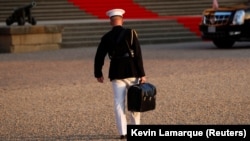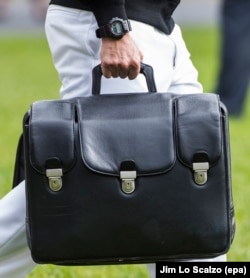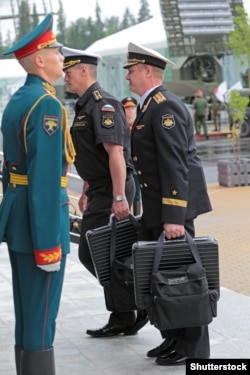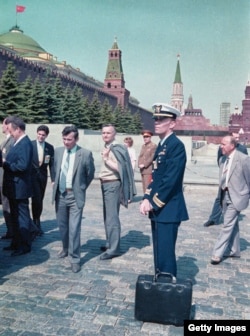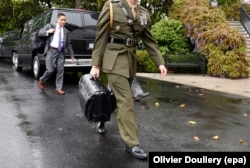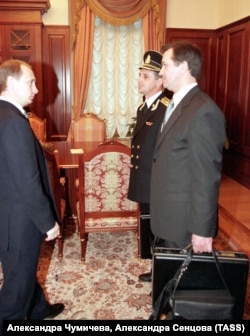A historical look at the "nuclear suitcases" that accompany the Russian and U.S. leaders wherever they go, including this week when Joe Biden and Vladimir Putin are in Geneva for a summit.
This leather satchel is known as the United States' "nuclear football."
And these hardcase containers carried by Russian servicemen are known as the "Cheget" system. The nuclear briefcases are named after a mountain in Russia's Caucasus region.
Both countries' doomsday devices will be somewhere close at hand when U.S. President Joe Biden and his Russian counterpart, Vladimir Putin, meet in Geneva on June 16. The frightening hand luggage enables its owner to destroy much of civilization by ordering nuclear missile strikes from anywhere on Earth.
The U.S. "football" is, in fact, a metal case that reportedly includes several booklets, including one that offers up a grim "menu" of potential targets for nuclear strikes. The suitcase also includes a list of secret bunkers where the president and his staff can take refuge during a nuclear war. The case is bundled into a leather bag alongside communications equipment.
The football reportedly got its odd name from an early plan for launching nuclear war called Operation Dropkick, the implication being that a ball was needed to launch a kick.
The football first appeared in public after the 1962 Cuban missile crisis. President John F. Kennedy had grilled his advisers on how the United States could launch an "immediate" nuclear strike while guaranteeing the orders were coming directly from the president.
Along with the football, U.S. presidents personally carry a card known as the "biscuit" with codes that would verify it is indeed the commander in chief issuing orders through the football. The vice president is issued with the same system in case the president is incapacitated.
The military staff tasked with carrying the football is rotated from each of the military's six service branches and undergoes the country's most stringent background check.
Far less is known about the system that Russian leaders would use to activate a nuclear strike. It is reported that the Kremlin's briefcases began operation in 1983, and thanks to a central Russian museum we can see inside one of the early iterations of the device.
The suitcase in the photo, which was put on display in the Yeltsin Center in 2015, was issued to Boris Yeltsin during his 1991-99 presidency.
The three buttons on the left are labeled "recommend, cancel input, and confirm." The red button on the right says "transmit." The device was reportedly designed to be extremely simple to use for the sake of the Soviet Union's often elderly leaders.
Russia's suitcase-carrying servicemen are reportedly always in the uniform of naval officers to make them easy to spot in a crowded entourage.
At the summit in Switzerland on June 16, sharp-eyed viewers may be able to spot the U.S. and Russian suitcases. At similar events in the past the devices were usually within a few meters of the nuclear-armed leaders.




